In this video I show a couple cuneiform tablets that I made for Inanna, and then I show how I make my tablets. I also talk a little bit about the Sumerian language and my relationship with Inanna.
Category: Sumerian Language
Dumuzid – And My December Rituals
In December I finished the second section of the Rod and Ring initiatory journey. For the main ritual I met Dumuzi/Dumuzid (I see both spellings equally when reading about Sumerian religion, so I’m not sure which is actually the preferred rendering of his name – so far I haven’t gotten any sort of sense that He prefers one or the other like I did with Amageshtin/Geshtinanna).
As with the Geshtinanna, I was already familiar with Dumuzi before meeting him in this ritual. Aside from Inanna Herself, Dumuzi and Ninshubur are the deities I most revere (I only began working with Geshtinanna in the last several months).
To be honest, I was a bit hesitant to start worshiping Dumuzi to begin with because I wasn’t all that interested in having male deities. Which is also part of why I was never really interested in learning about Wicca when I started learning about paganism and witchcraft. I’m sure there’s some psychological reasons in there that I need to uncover and deal with through shadow work, but I digress.
To enhance the experience with Dumuzi, I also started reading Samuel’s newest book, The Red Shepherd right before the last new moon. I expanded on the rituals of thanksgiving for the 3rd, 4th, 5th, and 6th nights of the Rod and Ring initiation by also incorporating the liturgy from the Red Shepherd and extending the ritual activity by 2 days to make room for all 6 liturgical texts.
There was one final ritual for this part of Rod and Ring to be done on the full moon, so I did that on the 26th. I skipped doing the ritual from another book I’m going through, Evil Speech Stand Aside, last month, and I’ll just start doing them on months when I don’t have another full moon ritual to do to make it last longer, rather than doing a bunch of different things on one night.
I also did the Sheepfold rite from the Red Shepherd already, and plan to do the rest of the rites throughout the year. I’ll write more about those later. I’m not actually going by the Babylonian calendar to schedule these like the book suggested since the agricultural cycle of the US is different from that of Mesopotamia, and my lifestyle isn’t really based on the agricultural cycle anyway as a suburban woman in 2024. The next section of Rod and Ring skips some months, so I’ll probably start doing the Red Shepherd rites around the new moon of months that I don’t do Rod and Ring activities.
I did something different for my artwork offering this month. I got a set of watercolor pencils for Christmas, so I wanted to experiment with those. I have no idea what I’m doing with them, but I suppose that’s also the case with most things…
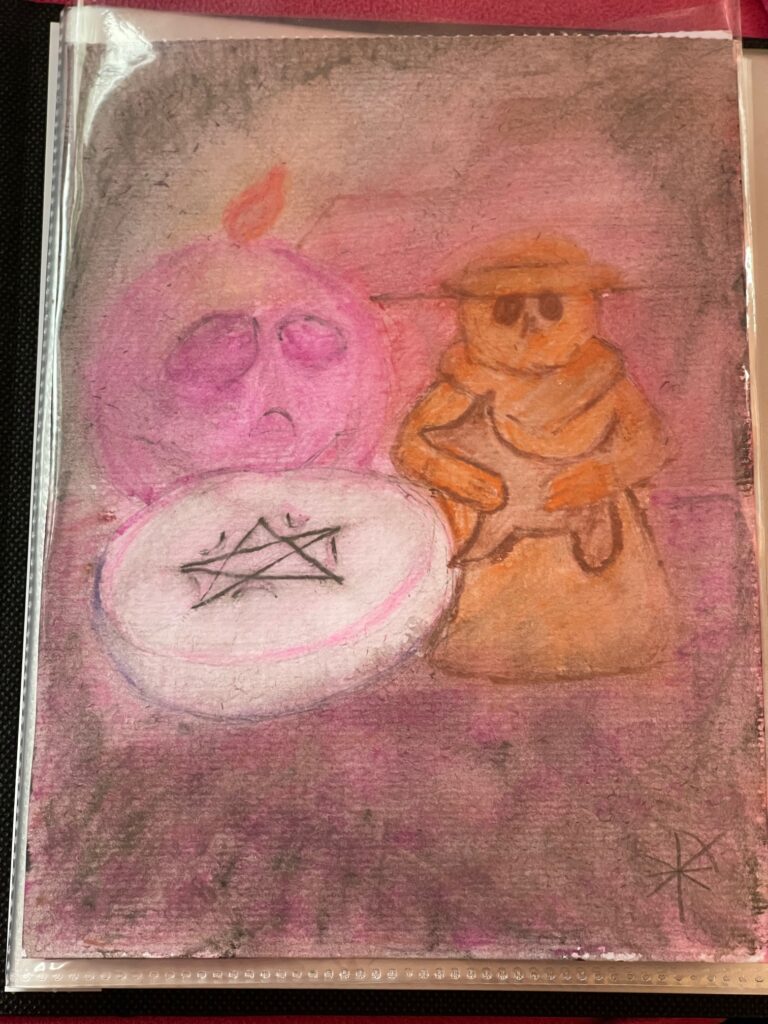
The first one is a painting of my statue of Dumuzi (which I based on an ancient figurine of a shepherd found in Girsu/Tell Telloh. The original probably wasn’t meant to be Dumuzi, but I am just so amused by how that particular statue looks, I had to recreate it), along with my skull candle holder and selenite plate. I just thought it looked nice on my altar during the rituals, so I made the painting to commemorate the ritual itself in addition to the deity. These items could also represent earth and the underworld.
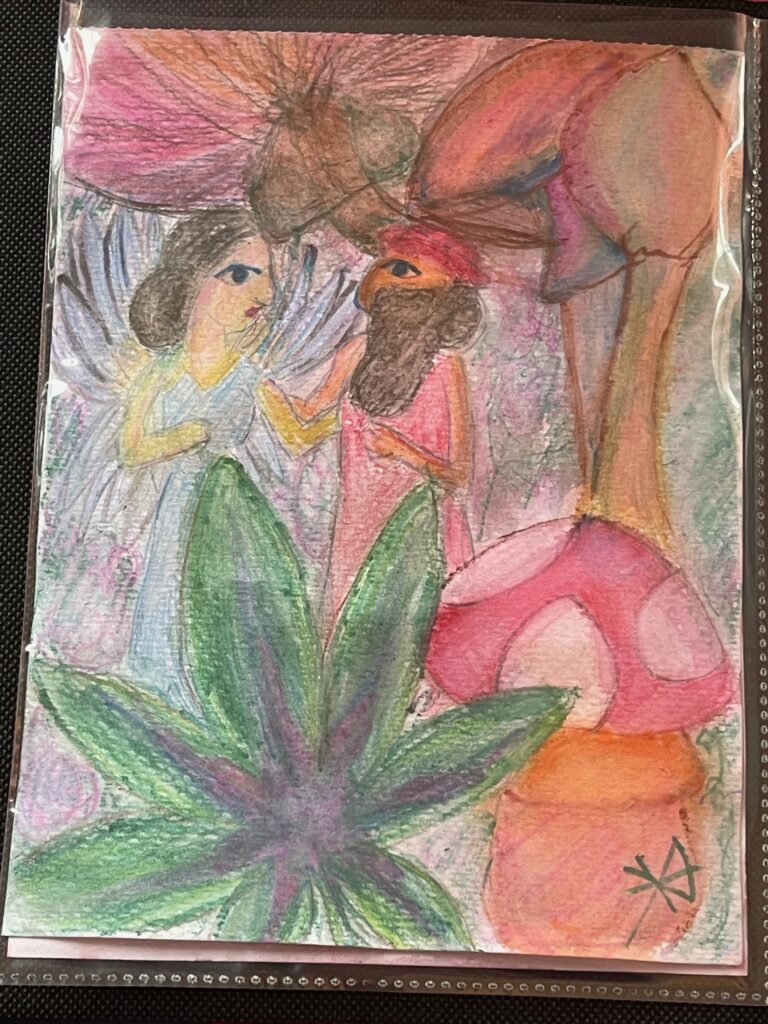
I also made a rendition of Inanna and Dumuzi, based on a relief carving depicting their marriage. I have no idea why I interpreted it in this way…
For Yule/winter solstice, I just did a simple Yule Log ritual and gave Inanna a special gift/offering. I don’t know that the Sumerians actually had a celebration for winter solstice, but I’ve been adapting different holidays and celebrations to fit my own religious practices. I used a small bit of apple wood for my yule log. It came from my apple tree that was destroyed in a snowstorm a few years ago. We cut down the remains of the tree but left the stump. The tree is regrowing now, and the wood I used was from the regrowth, symbolizing a time of rebirth and renewal.
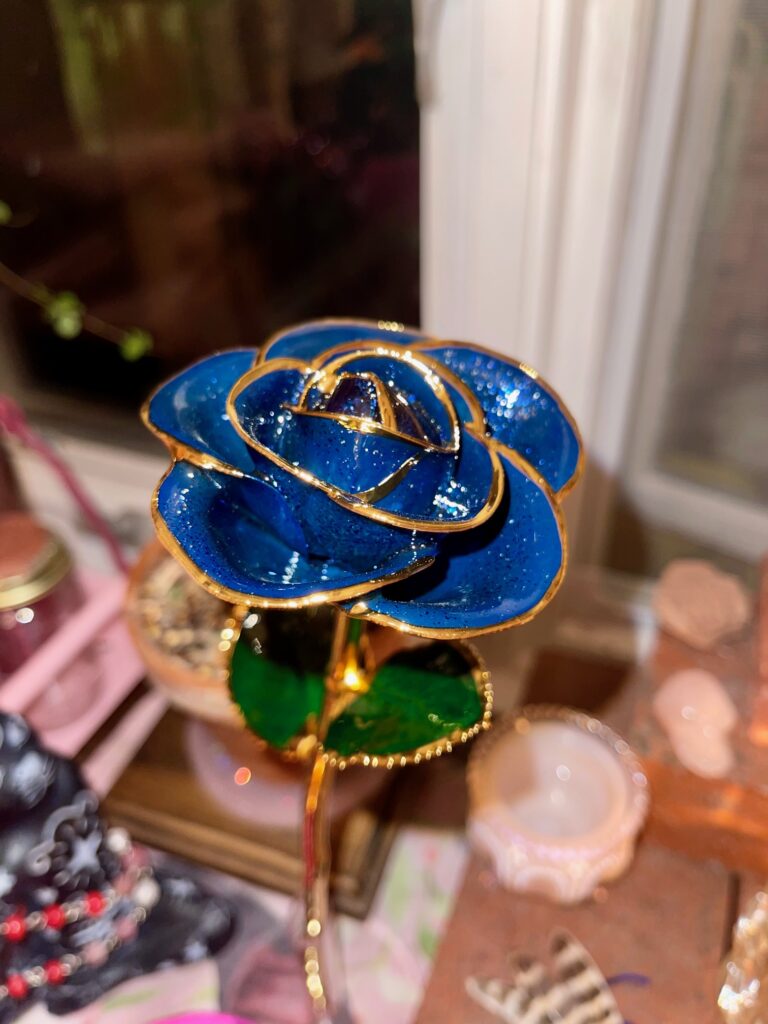
I like to give Inanna offerings of fresh roses from my garden throughout the growing season and was sad that I won’t be able to grow any for several months, so I got Her a gold dipped rose (which is a product I only knew about from listening to Howard Stern, so I hope She isn’t too offended! lol). I picked a sparkly blue one that reminds me of lapis lazuli and the night sky.
On Christmas, I decided it would be most appropriate to honor Dumuzi. I was already working with him a lot in December through the Rod and Ring initiatory rituals. And of all my deities, he is most similar to the Christian one, being a shepherd god and male. I gave him a nice offering of cheese on Christmas day. It was a simple and quick ritual.
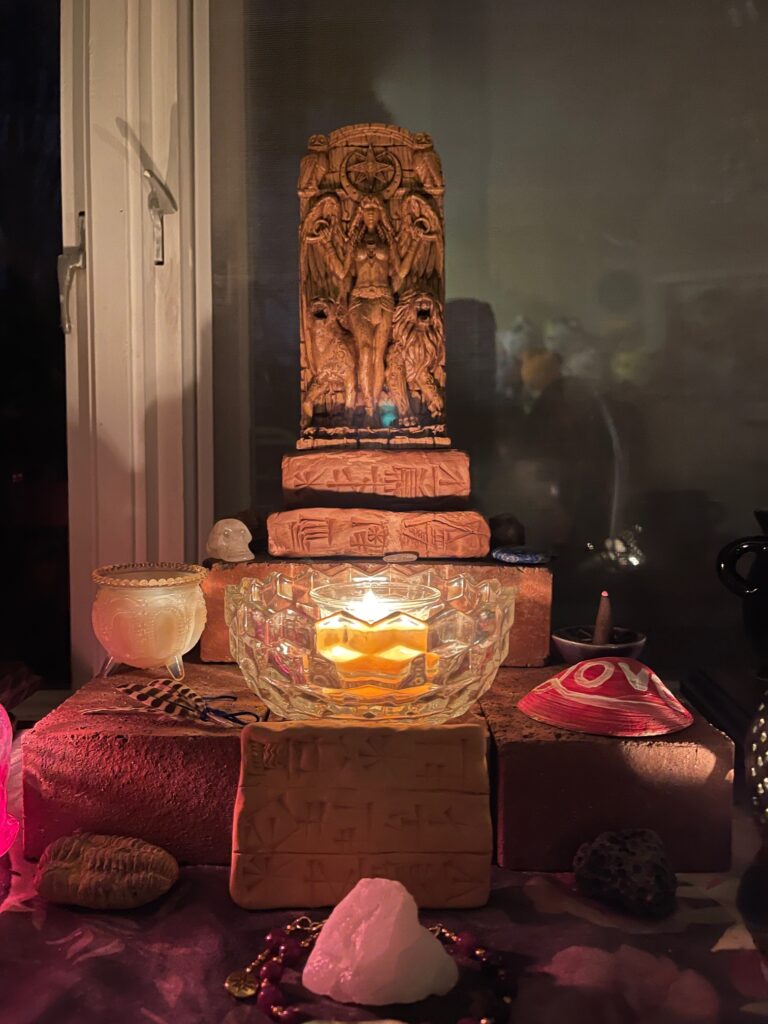
Back in November, did something similar, but a little bit more involved, to adapt Thanksgiving. I did a feast for all of my deities with offerings of things that they enjoy (like cheese for Dumuzi, dates for Inanna, etc.) right after doing a ritual to rededicate my temple to Inanna. I had recently thought of a name for my personal temple, E Ama Piring, Temple of the Mother Lioness, and I made a brick with the name inscribed in cuneiform to add to the dais, so I thought that improvement deserved a re-dedication ceremony (I hadn’t yet read ahead enough in Rod and Ring to know that I will be doing a temple dedication as part of my initiatory journey anyway, but that’s okay. That’s still months away and I’m sure I will have made plenty more changes by then).
Inanna and the Huluppu Tree – Children’s Book Progress
I’ve been working on a new children’s picture book based on the Mesopotamian myth of the Huluppu Tree. I’m hoping to have it ready to release next month, by Thanksgiving (and the holiday shopping season!)
I wrote first draft of the text last month. I based it mostly on the popular translation by Samuel Noah Kramer, but simplified for the children’s picture book format. I did change “Lilith” to an owl, as respectable Assyriologists now agree that the Sumerian term ki-sikil-lil-la-ke from the original Sumerian version of the myth isn’t related to the Semitic folklore figure Lilith. One theory is that this inhabitant of the tree was simply meant to be an owl. It may have also been meant to represent a spirit or demon of some sort. For the purpose of a children’s book, I think that an owl is the best translation to get the point across. Owls are mysterious creatures of the night, while still being something that a child raised in the modern world can understand (without having nightmares).
In addition to the draft of the story adaptation itself, have also completed the story board and started working on the illustrations. I’m about a third of the way through drawing the illustrations right now. In the illustrations, I have interpreted the Huluppu tree as a willow-like tree. There are other interpretations of what kind of tree the Huluppu tree could have been, but willow seems to be the most common interpretation. I’ve also seen it proposed as a date palm. Aside from the willow interpretation being more popular, I think the symbolism and magickal properties of the willow tree work a little bit better than the date palm. Willows feel like they have a more feminine type of energy than the date palm to me, and they can symbolize rebirth, healing, and rapid growth. (The date palm would also have been a good choice symbolically, as they can represent fertility and abundance, though I feel like the willow is slightly more fitting for the purpose of this book).
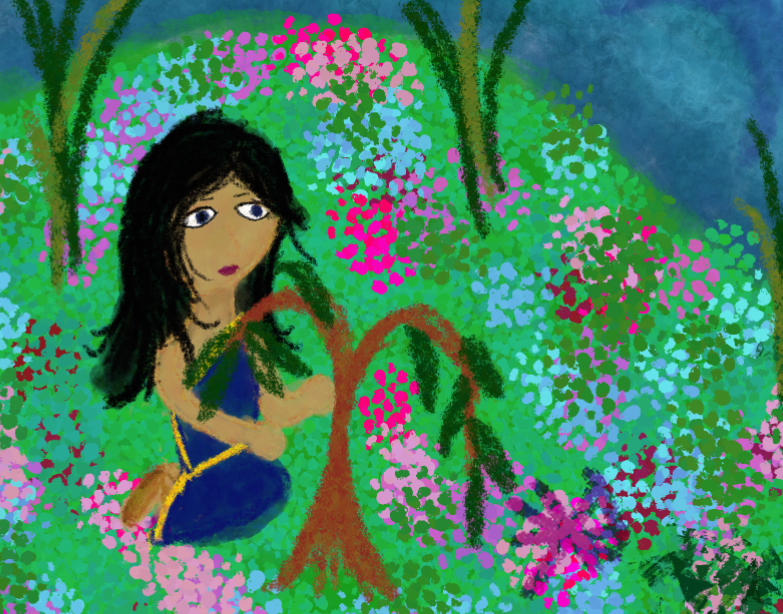
I still need to finish the illustrations, write the text for the front and back matter (glossary, brief historical overview, about the author, etc), and revise and edit the text and illustrations.
If this project goes well and there is any interest, I may eventually make a whole series of children’s books based on Sumerian myths. I will likely focus mainly on myths involving goddesses, especially Inanna.
I got the idea to write children’s books based on Mesopotamian mythology from the one existing picture book I found based on Inanna’s Descent. That one got the story completely wrong and changed so many details that it was completely unrecognizable aside from the characters’ names. I’d like to write my own children’s book version of the Descent myth and the myth where Inanna receives the mes from Enki. The challenge will be adapting them to be appropriate for modern-day children while still remaining accurate to the original myths.
I also have an idea for an novel (or more likely, novella – right now I’m estimating about 30,000-40,000ish words, though that could always change drastically as I add and/or remove ideas – I’m still in the very early stages of planning) based on the myths involving Inanna as well. I’m working on researching and outlining it now, and I’m planning to start writing it next month during NaNoWriMo. While I plan to write during NaNoWriMo, I think I’m going to do the challenge in a non-traditional way this year. I’m planning on writing the first draft for this short novel, and also finish up the children’s book during November, but not get caught up on word counts. I want this book to be more of a lyrical, succinct style, reminiscent of books like Hermann Hesse’s Siddhartha and the like. Something that has spiritual value, and that feels more like a classic rather than just another run-of-the-mill fantasy based loosely on mythology.
Whenever I do NaNoWriMo, I tend to get too caught up on quantity of words, rather than quality. This means I end up with a manuscript filled with useless nonsense that I never feel like wading through to salvage a story that I actually want to share with anyone. I like NaNoWriMo for the fact that it pushes me to write even when I don’t feel like I have the time, but I also recognize that it does encourage the bad habit of writing in a way that focuses on higher word counts over quality story telling.
Nisaba and the Invention of Writing, and Nanna and the New Moon (paintings)

I made this painting for Nisaba, the Sumerian Goddess associated with writing, and also grain, after performing her rituals for Rod and Ring this month. I want to do something extra to honor each deity as I complete their rituals. I call is Dub Sar: Nisaba and the Invention of Writing. She was originally associated with grain, but became associated with writing after its invention due to the use of reeds as styluses. I used the most famous carved image of Nisaba as the inspiration, but switched the grain stalks she held for her lapis tablet and golden stylus to emphasis her importance as a patron goddess of scribes, know as dub sar in Sumerian.
I was originally writing articles for HubPage’s network site Exemplore (where they route all pagan-related topics, along with other, but decided to switch to paintings. I still need to go back and complete my paintings for Gibil, Ninurta, and Ishkur. I’ve realized that HubPages isn’t the best place to try to elevate the gods since they lump all things pagan in with garbage like conspiracy theories, UFOs and Aliens, New Age, etc.

I also did a painting for Nanna this month during the dark moon. I call it Udnua, which means New Moon in Sumerian. This one features Nanna seated before the dark moon. I made the initial sketch by tracing one of my favorite stone images of him. I tried to emphasize the shining gold details of the Shining One and his divine magical accoutrements.
Both of these art peices are available as prints from my various art sales channels. I particularly recommend these mini prints that come with wooded bases, available on my Threadless Artist Shop. These are perfect to use as images of the deities for your altar or shrine!
So far I have Inanna, Marduk, Nanna, and Nisaba. I’m working on making one for Dumuzi, and will soon start painting Gibil, Ninurta, and Ishkur. Next month I will start working on one for Ningal, and then Gestinanna after I complete their rituals for Rod and Ring. I’m already working on one for Dumuzi, but I might make another one once I complete his ritual.
Til Zu-Bir Ki-Aĝ (Live Laugh Love) Cuneiform Tablet
I translated the phrase “Live Laugh Love” into cuneiform to make a tablet to hang on the wall. I realized that, for someone who loves pumpkin spice lattes and is just generally a “basic white girl,” I didn’t have any of the the type of artwork that is generally associated with “basic bitches” hanging up in my house. You know the type, random words just displayed on the wall for no reason. So I remedied that with my own spin.
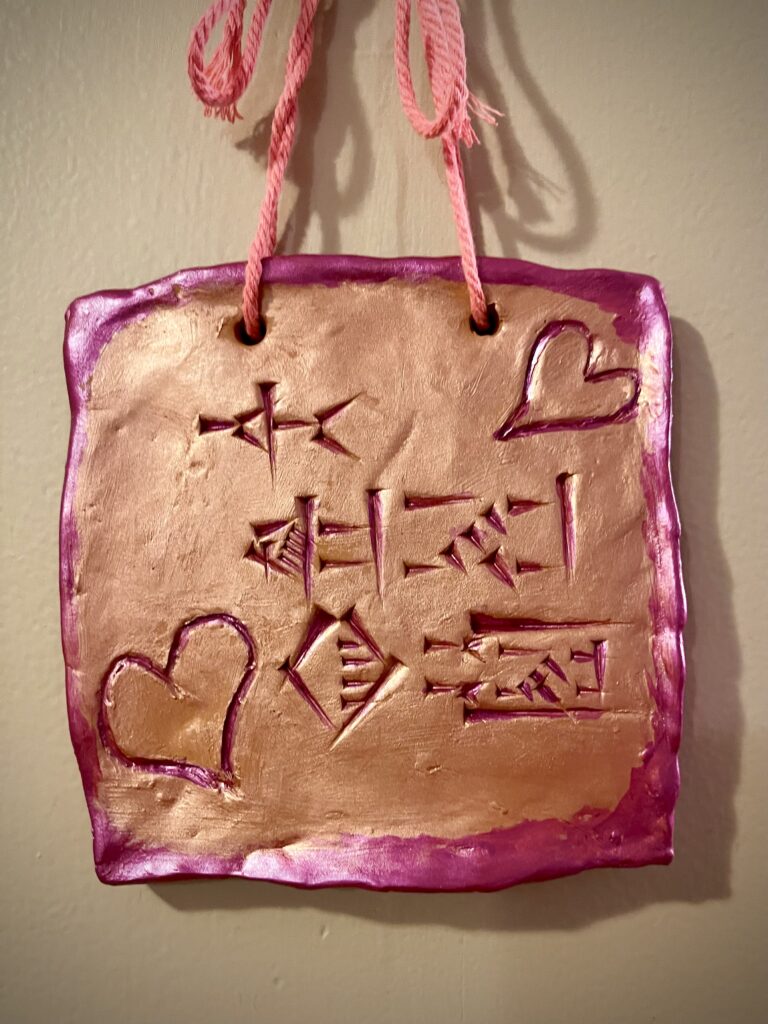
Most of my tablets I just leave plain because I like the old-timey ancient look, but this one felt like it needed something more, being a translation of a modern-day saying, so I carved a couple hearts and painted it with some metallic paint I had left over from painting a brick to make a bookend a while ago.
I’m working on utilizing print-on-demand services to offer canvas prints and t-shirts featuring this translation.
I’d also be open to taking a few commissions here and there if anyone is interested in commissioning a similar clay tablet (or one with something less silly written on it). I’m hoping to continue improving my art skills and developing them into a viable “side hustle” in case I get sick again and have to take a break from my regular day job (apparently I’m dumb for continuing to work in a daycare throughout chemo and radiation last year, but w/e. I do what I want!).
T-Shirts and Merch – Nybiru Studio Relaunch (phase 1)
I had an idea to start an online shop to sell artwork, particularly sculptures and cuneiform tablets, which then led to the idea to make other kinds of more marketable wearable art too. Since I found a website that will print and ship items with my designs for me, I’m starting with that while I work on deciding where to sell physical artwork (as well as testing and choosing the best clay and other materials to use for my sculptures, and working on creating molds to reproduce small figurines, altar tools, etc that I make).
Anyway, since I already have my LLC that I haven’t done much with, I’m going to relaunch it for my artwork. Since in was originally for my game Petal Quest, and then I added my self-published books as part of the business, I don’t think it’s that much of a stretch to also add other types of art.
I’m using SpreadShop to sell shirts, stickers, mugs, and more. I have a few simpler designs ready to go, and a few more complex design ideas I’ve started drawing (I have a bad habit of jumping between different pieces as I think of new ideas, but they will all get done eventually). I have two different categories so far: “Fun and Memes” for silly things I think of, such as a shirt that says “Live Laugh Love” translated into Sumerian; and “Sumerian Polytheism” for designs to show your devotion to the deities of the Sumerian pantheon. I’m planning on making some designs for other pagan paths as well. My SpreadShop link is nybiru-studio.myspreadshop.com.

I’m waiting to promote anything on social media until the sample items I ordered arrive. I want to make sure everything is good enough quality, especially for the items bearing deities’ symbols.
For the physical artwork, I’m looking into using either Etsy or ArtPal, but I want to see what other options are out there too. Etsy is the most well-known site for selling artwork, so it’s probably the best choice for gaining exposure, but a lot of artists I know are moving away from there because of their excessive fees. I don’t know much about ArtPal, but it looks like they don’t take so much profits, and they also offer print-on-demand art prints in case I ever want to offer something like that as well.
I want to redesign my business website one of these days too. There’s a way to embed the SpreadShirt shop into my own website, so I’ll probably do that to make it more professional. I’ve started rewriting the copy for Nybiru Studio too. I’m also in the process of replacing text containing the accented ý with a normal y since it gets rendered weird sometimes, and the legal name is Nybiru Studio, LLC. This is what I put for the About page:
About Nybiru Studio
Nybiru Studio is in the processes of relaunching with a new array of Mesopotamian- and pagan-inspired artwork, altar tools, and clothing items.
The first phase of this relaunch will include wearable items and other accessories featuring my digital artwork. These items will be processed, printed, and shipped by my manufacturer.
Next, I am planning on launching a shop for handmade clay artwork, including figurines, altar tools, cuneiform tablets, and more. This is going to take more time to launch. I’m still looking into options for hosting this shop/processing payments.
I originally started this company to publish and market my game Petal Quest. Eventually I expanded it to include my books and other artistic pursuits.
About the Artist
Jennifer is an artist, writer, and Sumerian polytheist. She started working with clay to practice writing cuneiform while learning the Sumerian language and quickly discovered a love for sculpture, which she has found to be an excellent creative outlet and means of regaining fine motor strength after suffering neuropathy of the hands after chemo for breast cancer.
She began learning Sumerian as a means of connecting deeper with the Sumerian deities, particularly the goddess Inanna.
Aside from art and sculpture, Jennifer has a background in writing and graphic design for a variety of different genres and industries. She has published several books including a YA novel, a comic book, and a children’s ABC picture book.
Jennifer holds a Bachelor of Arts in English and Creative writing from Southern New Hampshire University, and an Associate of Applied Science in Computer Games and Simulation Design and an Associate of Arts from Lorain County Community College.
What Does the Name Nybiru Mean?
Nybiru Studio comes from Jennifer’s nickname “Ný” and the word “Nibiru.”
Nibiru is a term that appears in ancient cuneiform tablets to refer to a crossing point over a river, such as by boat or ferry. It can also be used to refer to certain astronomical phenomena involving crossing points of the planets, particularly Jupiter.
“Nibiru” may also refer to a fictional planet that conspiracy theorists claim is the home of aliens who visit Earth from time to time. These theories have no basis in reality and no scientific or archeological support, but they can be fun for science fiction writers to play with!
Visit Nybiru.com
Lastest Clay Artwork: Cuneiform Tablet, Inanna Pocket Figurine, Tiny Cuneiform Tokens
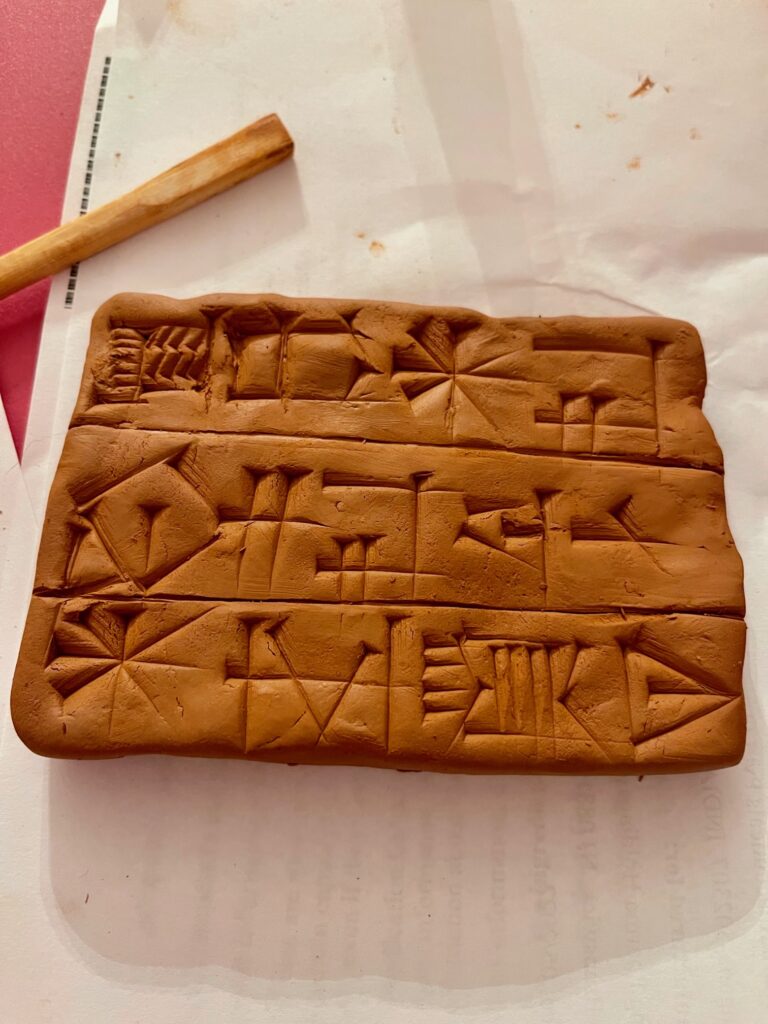
I made this tablet last Friday in the middle of the night when I couldn’t sleep. Translated to English it says: “The strength of my god completes my own. Inanna zami.”
The first part is a Sumerian proverb. There is some debate over the authenticity of this quote, but it is listed in the CDLI. Besides, I like the quote.
usu diĝir-ĝa2 ni2-ĝa2 ba-til
𒀉𒄨𒀭𒂷𒉎𒂷𒁀 𒌀
The second part, Inanna Zami, means “Inanna be praised.”
𒀭𒈹𒍠𒊩
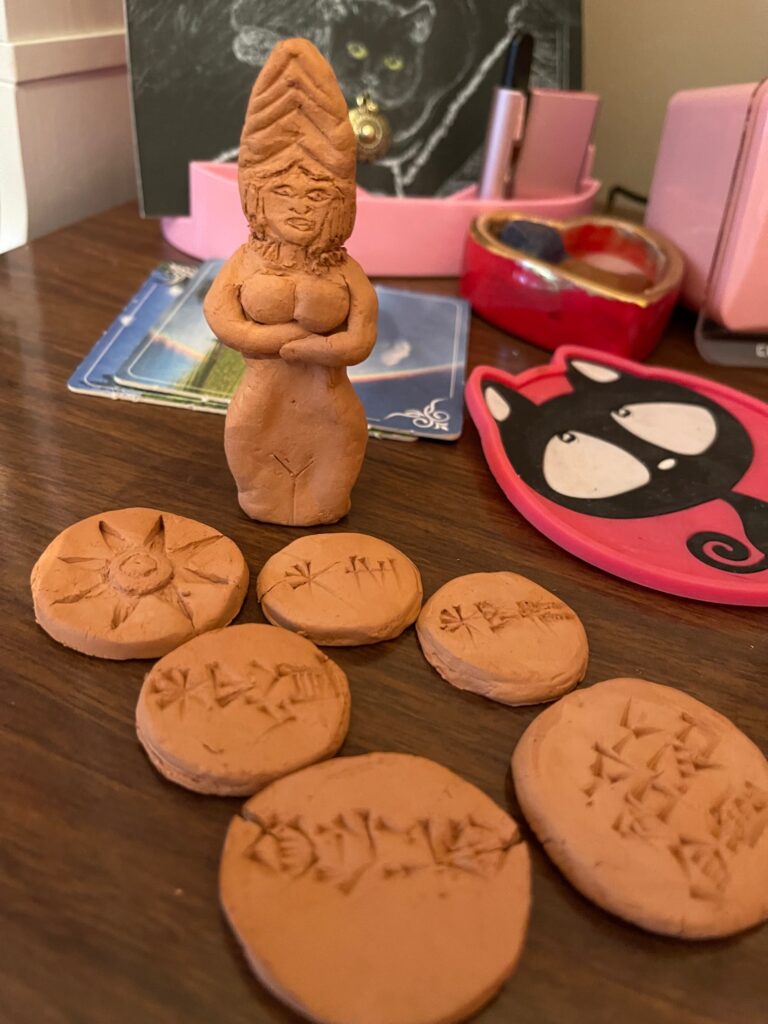
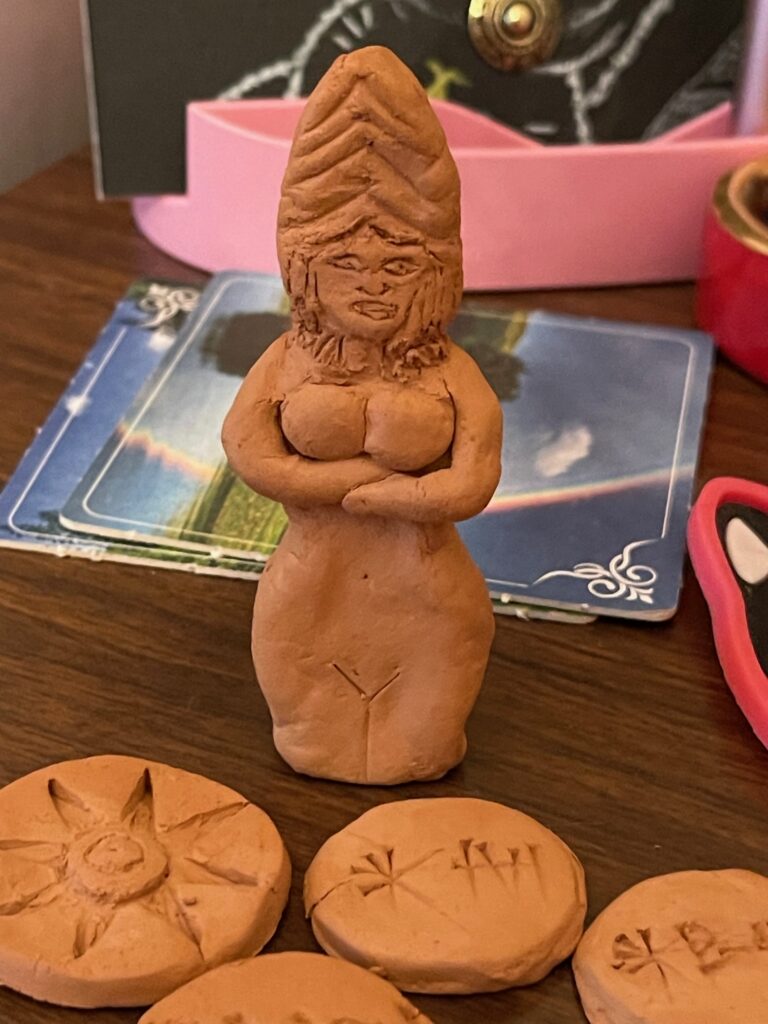
Then on Sunday I made a new cuneiform stylus to make smaller wedges and tried it out by making these tiny clay tokens. I made ones featuring the names of Inanna, Ninshubur, and Dumuzi. I also made a smaller version of the “Go Away” amulet that I made earlier and one that translates to “Live, Laugh, Love” for funsies. I made the new stylus from one of those sticks that comes with poly-fil stuffing and squared it off on the end. Well, it’s more of a triangle than a square.
Then I made a similarly-sized token featuring Inanna’s star to test out my new set of clay carving tools. After making all of these simple projects I felt like trying my hand at sculpting something more complex. I decided to make a small pocket-sized figurine of Inanna for a travel altar. I wanted something small and simple to practice sculpting. I posed Her arms crossed against Her body so they wouldn’t be broken as easily during travel, but She kinda just looks like She’s done with my shit, so I feel like I should carry this representation of Her with me when I know I’m about to make poor decisions.
I already want to make a larger similar statue with more details representing more of Her iconography, including Her 8-point star, and the rod and ring symbol that frequently appears in images of deities in Mesopotamian art.
My Latest Cuneiform Practice Tablets
I wanted to practice my cuneiform writing on smaller projects before attempting a larger tablet I want to make soon, so I made a couple smaller things over the weekend.
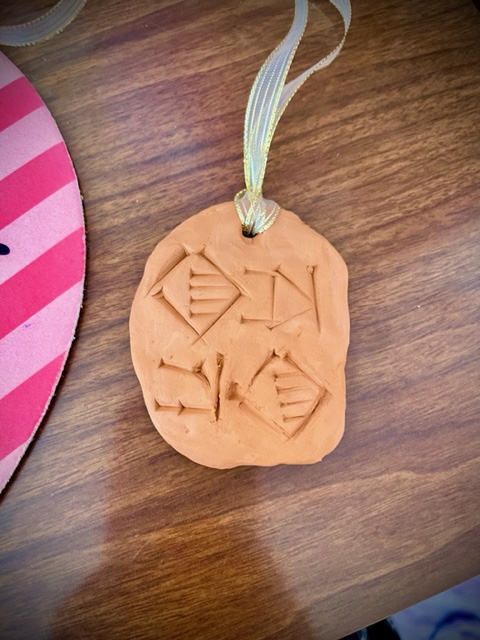
The first is a “magickal” amulet meant to keep people (by “people” I mean my husband) out of the room while I’m doing ritual work. Or if I just feel like being alone. It has many uses! The cuneiform says “kita ĝena,” 𒆠𒋫 𒁺𒈾, which means “go away” (lit. “leave from here!”). I found this translation on a Tumblr blog called Sumerian Language. I put a hole with a ribbon through it so it can be hanged on the door.
I didn’t actually do any type of magickal working on it. It’s really more of a “privacy please” sign. If you need magick to keep the people you live with out when you need alone time, you should probably find new people…
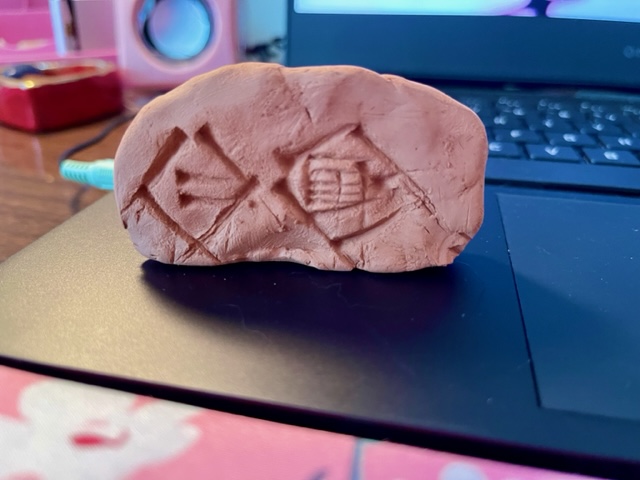
The second tablet says 𒁲𒄳, “Hello world!” I made it for my husband, who is a programmer. I just thought it was amusing to use the world’s first written language to make a representation of the first program everyone ever makes when learning a new programming language because I’m a dork. It is transliterated as “silim gulkin.” Silim, 𒁲, was used as a greeting, and literally means “to be healthy.” Gulkin, 𒄳, means “inhabited world.”
I found the “Hello World” translation on the same Tumblr blog as above. That blog seems really good for finding translations of things that are useful in the modern world. It appears that the author there frequently takes translation requests from other Tumblr users.
While making these tablets, I also figured out that this particular clay I am using requires about 3600 times more water than I think I should use while forming the tablets to prevent cracking (the air in my house is very dry). I’m still working on my technique, but I’m confident I can get them to actually look nice eventually. I’ll probably try a different brand of clay that someone recommended to me on FaceBook after I run out of my current supply, however.
How to Make Cuneiform Flashcards from Clay to Study the Sumerian Language
I just finished Learn to Read Ancient Sumerian: An Introduction for Complete Beginners by Joshua Bowen and Megan Lewis (other than the additional exercises in the appendix), as well as their YouTube series that goes along with the book. I feel like I need to go back through the whole book and video course to really understand it and memorize everything, however. Verbal chains are hard!
Anyway, I had the idea to make little “flashcards” from clay to help me memorize the cuneiform signs. I made them for the signs shown in every chapter of the book. Here is an article I wrote on how I made them:
Learning to Read Sumerian: How to Make Clay Cuneiform Flashcards
I used air-dry clay for the mini-tablets and I made a stylus from a disposable chopstick that I whittled a bit to make the edges more defined.
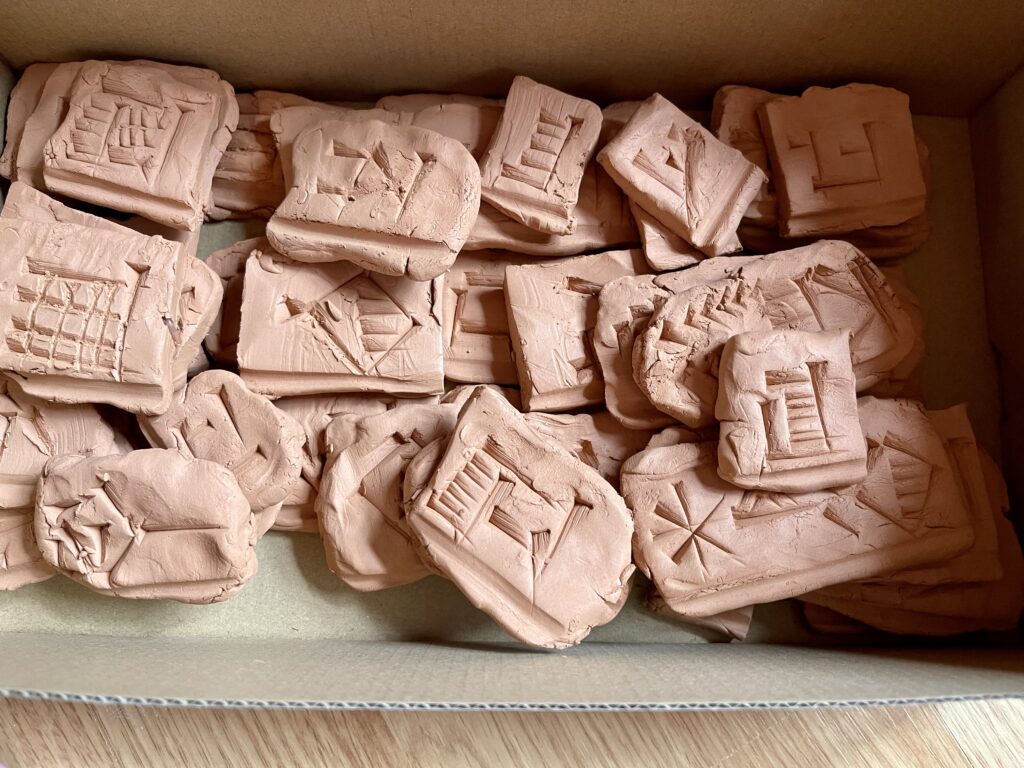
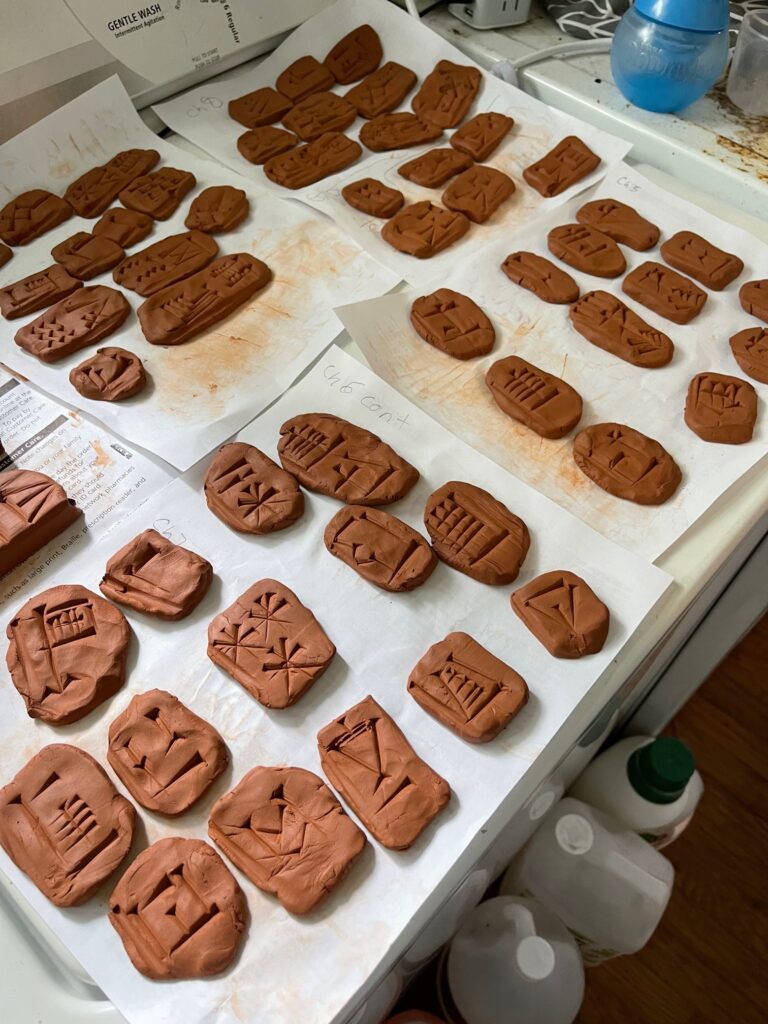
I know my cuneiform handwriting isn’t the neatest, but neither is my modern handwriting.